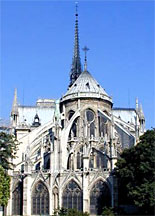 View of apse and flying buttresses at Notre-Dame, Paris. © Vitruvio.ch: Architecture on the Web |
|
||
In architecture, an apse {aps} is a projecting space, usually semicircular or polygonal in plan, in a religious or secular building. A common feature of Early Christian and medieval churches, the apse is usually located behind the choir at the east end of a church. It may also be placed at either end of the transept, and it is often topped by a half dome.
The apse first appeared in pre-Christian Roman architecture. It frequently took the form of a deep niche in a temple where the monumental statue of a deity was placed. The form was also used in the Roman basilica, usually to terminate the central aisle. This usage was adopted in Early Christian churches. In the earliest examples the clergy sat in the apse, separated from the body of the church by the altar, which stood just before it. Later, the seats of the clergy were moved forward into the choir, and the altar was placed in the apse.
As the place where the liturgical services were performed, the apse was the central focus and the most sacred part of the church. It was often richly decorated with marble, mosaic, or paintings. In the Gothic period small chapels, called apsidal chapels, were sometimes placed at the rear of the apse.
In secular architecture — particularly in the 18th century, when Roman forms were imitated — apses were often used as terminations of long passages or as locations for statuary. The British architect Robert Adam incorporated apses in many of his designs.